Impact of Block Spatial Optimization and Vegetation Configuration on the Reduction of PM2.5 Concentrations: A Roadmap towards Green Transformation and Sustainable Development
Abstract
:1. Introduction
2. Research Subject and Process
2.1. Research Subject
2.2. Sources of Pollution
2.3. Research Process
3. Research Methods
3.1. Fluent Configuration
3.1.1. Fluent Modeling and Grid Setting
3.1.2. Turbulence Model, Wind Speed Distribution, Boundary Conditions, and Convergence Criteria
3.2. PM2.5 Particulate Matter Concentrations in Different Green Space Structures
3.2.1. Field Monitoring of PM2.5 Particulate Matter Concentrations in Different Green Space Structures
Monitoring Equipment
Monitor Points
3.2.2. Comparison of Field Detection and Fluent Model Simulation
4. Results and Discussion
4.1. Characteristics of the Distribution of PM2.5 Concentration in Different Block Angle Types in the Prevailing Wind Direction
4.1.1. Characteristics of the PM2.5 Concentration Distribution of the 45° Angle of the Street in the Prevailing Wind Direction
4.1.2. Characteristics of the PM2.5 Concentration Distribution of the 90° Angle of the Street in the Prevailing Wind Direction
4.2. Analysis of Characteristics of the PM2.5 Concentration Distribution of Different Vegetation Types in Streets
4.3. Impact of Different Distances between Vegetation and Buildings in the Block on the PM2.5 Concentration Distribution
4.4. Variation and Analysis of the Effect of Vegetation Height and Different Heights of Buildings on Both Sides on PM2.5 Concentration
4.5. Impact of Different Street Tree Configurations on the PM2.5 Concentration Distribution in the Block
5. Conclusions
Author Contributions
Funding
Institutional Review Board Statement
Informed Consent Statement
Data Availability Statement
Conflicts of Interest
References
- Chen, M.; Dai, F. Effects of Urban Green Infrastructure Spatial Pattern on PM2.5 Based on MSPA. Chin. Landsc. Archit. 2020, 36, 63–68. [Google Scholar]
- Song, C.; Wu, L.; Xie, Y.; He, J.; Chen, X.; Wang, T.; Lin, Y.; Jin, T.; Wang, A.; Liu, Y.; et al. Air pollution in China: Status and spatiotemporal variations. Environ. Pollut. 2017, 227, 334–347. [Google Scholar] [CrossRef] [PubMed]
- Jiang, R.; Hong, B. Spatio-temporal Distribution Characteristics of PM2.5 and PM10 and Residents’ Exposure Risk Assessment in Residential Outdoor Open Spaces. Chin. Landsc. Archit. 2021, 37, 121–126. [Google Scholar]
- Dai, F.; Chen, M.; Wang, M.; Zhu, S.; Fu, F. Effect of Urban Block Form on Reducing Particulate Matter: A Case Study of Wuhan. Chin. Landsc. Archit. 2020, 36, 109–114. [Google Scholar]
- Razzaq, A.; Sharif, A.; Aziz, N.; Irfan, M.; Jermsittiparsert, K. Asymmetric link between environmental pollution and COVID-19 in the top ten affected states of US: A novel estimations from quantile-on-quantile approach. Environ. Res. 2020, 191, 110189. [Google Scholar] [CrossRef]
- Iqbal, W.; Tang, Y.M.; Chau, K.Y.; Irfan, M.; Mohsin, M. Nexus between air pollution and NCOV-2019 in China: Application of negative binomial regression analysis. Process. Saf. Environ. Prot. 2021, 150, 557–565. [Google Scholar] [CrossRef]
- Buccolieri, R.; Santiago, J.L.; Rivas, E.; Sanchez, B. Review on urban tree modeling in CFD simulations: Aerodynamic, deposition and thermal effects. Urban For. Urban Green. 2018, 31, 212–220. [Google Scholar] [CrossRef]
- Shirzadi, M.; Mirzaei, P.; Tominaga, Y. RANS model calibration using stochastic optimization for accuracy improvement of urban airflow CFD modeling. J. Build. Eng. 2020, 32, 101756. [Google Scholar] [CrossRef]
- Piroozmand, P.; Mussetti, G.; Allegrini, J.; Mohammadi, M.H.; Akrami, E.; Carmeliet, J. Coupled CFD framework with mesoscale urban climate model: Application to microscale urban flows with weak synoptic forcing. J. Wind. Eng. Ind. Aerodyn. 2020, 197, 104059. [Google Scholar] [CrossRef]
- Santiago, J.L.; Buccoloeri, R.; Rivas, E.; Calvete-Sogo, H.; Sanchez, B.; Martilli, A.; Alonso, R.; Elustondo, D.; Santamaria, J.M.; Martin, F. CFD modeling of vegetation barrier effects on the reduction of traffic-related pollutant concentration in an avenue of Pamplona, Spain. Sustain. Cities Soc. 2019, 48, 101559. [Google Scholar] [CrossRef]
- Kadaverugu, R.; Sharma, A.; Matli, C.; Biniwale, R. High-resolution urban air quality modeling by coupling CFD and mesoscale models: A review. Asia-Pac. J. Atmos. Sci. 2019, 55, 539–556. [Google Scholar] [CrossRef]
- San José, R.; Pérez, J.L.; Gonzalez-Barras, R.M. Assessment of mesoscale and microscale simulations of a NO2 episode supported by traffic modeling at the microscopic level. Sci. Total Environ. 2021, 752, 141992. [Google Scholar] [CrossRef] [PubMed]
- Kim, K.D.; Lee, S.Y.; Kim, J.-J.; Lee, S.H.; Lee, D.G.; Lee, J.B.; Choi, J.Y.; Kim, M.J. Effect of wet deposition on secondary inorganic aerosols using an urban-scale air quality model. Atmosphere 2021, 12, 168. [Google Scholar] [CrossRef]
- Park, S.-J.; Choi, W.; Kim, J.-J.; Kim, M.J.; Park, R.J.; Han, K.S.; Kang, G. Effects of building-roof cooling on the flow and dispersion of reactive pollutants in an idealized urban street canyon. Build. Environ. 2016, 109, 175–189. [Google Scholar] [CrossRef]
- Rodríguez, M.C.; Dupont-Courtade, L.; Oueslati, W. Air pollution and urban structure linkages: Evidence from European cities. Renew. Sustain. Energy Rev. 2016, 53, 1–9. [Google Scholar] [CrossRef]
- McCarty, J.; Kaza, N. Urban form and air quality in the United States. Landsc. Urban Plan. 2015, 139, 168–179. [Google Scholar] [CrossRef]
- Xiong, Y.; Zhou, J.; Schauer, J.J.; Yu, W.; Hu, Y. Seasonal and spatial differences in source contributions to PM2.5 in Wuhan, China. Sci. Total Environ. 2017, 577, 155–165. [Google Scholar] [CrossRef]
- Gu, K.K.; Cheng, F.; Yang, Q.Q. Analysis of multifunctional urban green infrastructure using a GISP model. Acta Ecol. Sin. 2018, 38, 7113–7119. [Google Scholar]
- Lei, Y.; Duan, Y.; Ma, G.; Tian, G. Influence of Urban Green Landscape Pattern on the Concentration of PM2.5/PM10 and Scale Effect in Zhengzhou, China. Chin. Landsc. Archit. 2018, 34, 98–103. [Google Scholar]
- Kenjere, S.; Kuile, B.T. Modeling and simulations of turbulent flows in urban areas with vegetation. J. Wind. Eng. Ind. Aerodyn. 2013, 123, 43–55. [Google Scholar] [CrossRef]
- Peng, C.; Ming, T.; Tao, Y.; Peng, Z. Numerical analysis on the thermal environment of an old city district during urban renewal. Energy Build. 2015, 89, 18–31. [Google Scholar] [CrossRef]
- Zhou, L.C. The Impact of GREEN Layout on the Flow Field and Pollutant Distribution around Buildings. Master’s Thesis, Donghua University, Shanghai, China, 2016. [Google Scholar]
- Liang, L.; Xiaofeng, L.; Borong, L.; Yingxin, Z. Simulation of canopy flows using k-ε equation turbulence model with source/sink terms. J. Tsinghua Univ. (Sci. Technol.) 2010, 46, 753–756. [Google Scholar]
- Liu, L.; Guan, D.S.; Chen, Y.Q. Morphological structure of leaves and dust-retaining capability of common street trees in Guangzhou Municipality. Acta Ecol. Sin. 2013, 33, 2604–2614. [Google Scholar] [CrossRef]
- Chang, H.; Xiang, C.; Duan, C.; Wan, Z.; Liu, Y.; Zheng, Y.; Shang, Y.; Liu, M.; Shu, S. Study on the Thermal Performance and Wind Environment in a Residential Community. Int. J. Hydrogen Energy 2016, 41, 15868–15878. [Google Scholar] [CrossRef]
- Wilcox, D.C. Turbulence Modeling for CFD; DCW Industries: La Canada, CA, USA, 2006; pp. 363–367. [Google Scholar]
- Rui, L.; Buccolieri, R.; Gao, Z.; Ding, W.; Shen, J. The impact of green space layouts on microclimate and air quality in residential districts of Nanjing, China. Forests 2018, 9, 224. [Google Scholar] [CrossRef]
- Tominaga, Y.; Mochida, A.; Yoshie, R.; Kataoka, H.; Nozu, T.; Yoshikawa, M.; Shirasawa, T. AIJ guidelines for practical applications of CFD to pedestrian wind environment around buildings. J. Wind. Eng. Ind. Aerodyn. 2018, 9, 224. [Google Scholar] [CrossRef]
- Blocken, B. Computational Fluid Dynamics for urban physics: Importance, scales, possibilities, limitations and ten tips and tricks towards accurate and reliable simulations. Build. Environ. 2015, 91, 219–245. [Google Scholar] [CrossRef]
- Park, S.J.; Kang, G.; Choi, W.; Kim, D.Y.; Kim, J.; Kim, J.J. Effects of Fences and Green Zones on the Air Flow and PM2.5 Concentration around a School in a Building-Congested District. Appl. Sci. 2021, 11, 9216. [Google Scholar] [CrossRef]
- Kang, G.; Kim, J.-J.; Choi, W. Computational fluid dynamics simulation of tree effects on pedestrian wind comfort in an urban area. Sustain. Cities Soc. 2020, 56, 102086. [Google Scholar] [CrossRef]
- Liu, B.Y. Modern Landscape Planning and Design; Southeast University Press: Nanjing, China, 2010. [Google Scholar]
- Meteorological Data Room of Meteorological Information Center of China Meteorological Administration, The Department of Architectural Science, Tsinghua University. Special Meteorological Data Set for Building Thermal Environment Analysis in China; China State Construction Industry Press: Beijing, China, 2005. [Google Scholar]
- Dai, F.; Chen, M.; Zhu, S.; Chen, H.; Fu, F. Effects of Different Green Coverage in Block Scale on PM10 and PM2.5 Removal—A Case Study of the Main City of Wuhan. Chin. Landsc. Archit. 2018, 34, 105–110. [Google Scholar]
- Zeng, Y.Z.; Chen, Y.R.; Guo, H.J.; Zhu, C.Y. Influencing Factors of Urban Lake Wetland of Built Environment on Air PM10/PM2.5 Concentration—A Case of Wuhan. Chin. Landsc. Archit. 2018, 34, 104–109. [Google Scholar]
- Lin, Z. Effective draft temperature for evaluating the performance of stratum ventilation. Build. Environ. 2011, 46, 1843–1850. [Google Scholar] [CrossRef]
- Lin, Z.; Yao, T.; Chow, T.T.; Fong, K.F.; Chan, L.S. Performance evaluation and design guidelines for stratum ventilation. Build. Environ. 2011, 46, 2267–2279. [Google Scholar] [CrossRef]
- Buccolieri, R.; Jeanjean, A.P.R.; Gatto, E.; Leigh, R.J. The impact of trees on street ventilation, NOx, and PM2.5 concentrations across heights in Marylebone Rd street canyon, central London. Sustain. Cities Soc. 2018, 41, 227–241. [Google Scholar] [CrossRef]
- Amorim, J.H.; Rodrigues, V.; Tavares, R.; Valente, J.; Borrego, C. CFD modeling of the aerodynamic effect of trees on urban air pollution dispersion. Sci. Total Environ. 2013, 461, 541–551. [Google Scholar] [CrossRef]
- Gromke, C.; Ruck, B. Pollutant Concentrations in Street Canyons of Different Aspect Ratio with Avenues of Trees for Various Wind Directions. Bound. Layer Meteorol. 2012, 144, 41–64. [Google Scholar] [CrossRef]
- Vranckx, S.; Vos, P.; Maiheu, B.; Janssen, S. Impact of trees on pollutant dispersion in street canyons: A numerical study of the annual average effects in Antwerp, Belgium. Sci. Total Environ. 2015, 532, 474–483. [Google Scholar] [CrossRef]
- Bowker, G.E.; Baldauf, R.; Isakov, V.; Khlystov, A.; Petersen, W. The effects of roadside structures on the transport and dispersion of ultrafine particles from highways. Atmos. Environ. 2007, 41, 8128–8139. [Google Scholar] [CrossRef]
- Kato, S.; Yang, J.H. Study on in-haled air quality in a personal air-conditioning environment using new scales of ventilation efficiency. Build. Environ. 2008, 43, 494–507. [Google Scholar] [CrossRef]
- Launder, B.E.; Spalding, D.B. Lectures in Mathematical Models of Turbulence; Academic Press: London, UK, 1972. [Google Scholar]
- Xue, F.; Li, X. The impact of roadside trees on traffic released PM10 in urban street canyon: Aerodynamic and deposition effects. Sustain. Cities Soc. 2017, 30, 195–204. [Google Scholar] [CrossRef]
- Lin, B.; Li, X.; Zhu, Y.; Qin, Y. Numerical simulation studies of the different vegetation patterns’ effects on outdoor pedestrian thermal comfort. J. Wind. Eng. Ind. Aerodyn. 2008, 96, 1707–1718. [Google Scholar] [CrossRef]
- Xie, X.; Liu, C.H.; Leung, D.Y.; Leung, M.K. Characteristics of air exchange in a street canyon with ground heating. Atmos. Environ. 2006, 40, 6396–6409. [Google Scholar] [CrossRef]
- Cheng, W.C.; Liu, C.H.; Leung, D.Y.C. Computational formulation for the evaluation of street canyon ventilation and pollutant removal performance. Atmos. Environ. 2008, 42, 9041–9051. [Google Scholar] [CrossRef]
- Livesley, S.J.; Mc Pherson, G.M.; Calfapietra, C. The Urban Forest and Ecosystem Services: Impacts on Urban Water, Heat, and Pollution Cycles at the Tree, Street, and City Scales. J. Environ. Qual. 2016, 45, 119–124. [Google Scholar] [CrossRef]
- Nosek, S.; Kukacka, L.; Kellnerova, R.; Jurcakova, K.; Janour, Z. Ventilation Processes in a Three-Dimensional Street Canyon. Bound. Layer Meteorol. 2016, 159, 259–284. [Google Scholar] [CrossRef]
- Llaguno, M.M.; Bou, Z.E.; Hultmark, M. The influence of building geometry on street canyon air flow: Validation of large eddy simulations against wind tunnel experiments. J. Wind. Eng. Ind. Aerodyn. 2017, 165, 115–130. [Google Scholar] [CrossRef]
- Tang, Z.; Ren, Z.; Zheng, H.; He, X. Cooling effects of urban forest community structure. Chin. J. Appl. Ecol. 2017, 28, 2823–2830. [Google Scholar]
- Schaubroeck, T.; Deckmyn, G.; Neirynck, J.; Staelens, J.; Adriaenssens, S.; Dewulf, J.; Muys, B.; Verheyen, K. Multilayered modeling of particulate matter removal by a growing forest over time, from plant surface deposition to washoff via rainfall. Environ. Sci. Technol. 2014, 48, 10785–10794. [Google Scholar] [CrossRef]
- Liu, X.; Yu, X.; Zhang, Z. PM2.5 Concentration Differences between Various Forest Types and Its Correlation with Forest Structure. Atmosphere 2015, 6, 1801–1815. [Google Scholar] [CrossRef] [Green Version]
- Kong, F.; Yan, W.; Zheng, G.; Yin, H.; Cavan, G.; Zhan, W.; Zhang, N.; Cheng, L. Retrieval of three-dimensional tree canopy and shade using terrestrial laser scanning (TLS) data to analyze the cooling effect of vegetation. Agric. For. Meteorol. 2016, 217, 234. [Google Scholar] [CrossRef]
- Wania, A.; Bruse, M.; Blond, N.; Weber, C. Analyzing the influence of different street vegetation on traffic-induced particle dispersion using microscale simulations. J. Environ. Manag. 2012, 94, 101. [Google Scholar] [CrossRef] [PubMed]
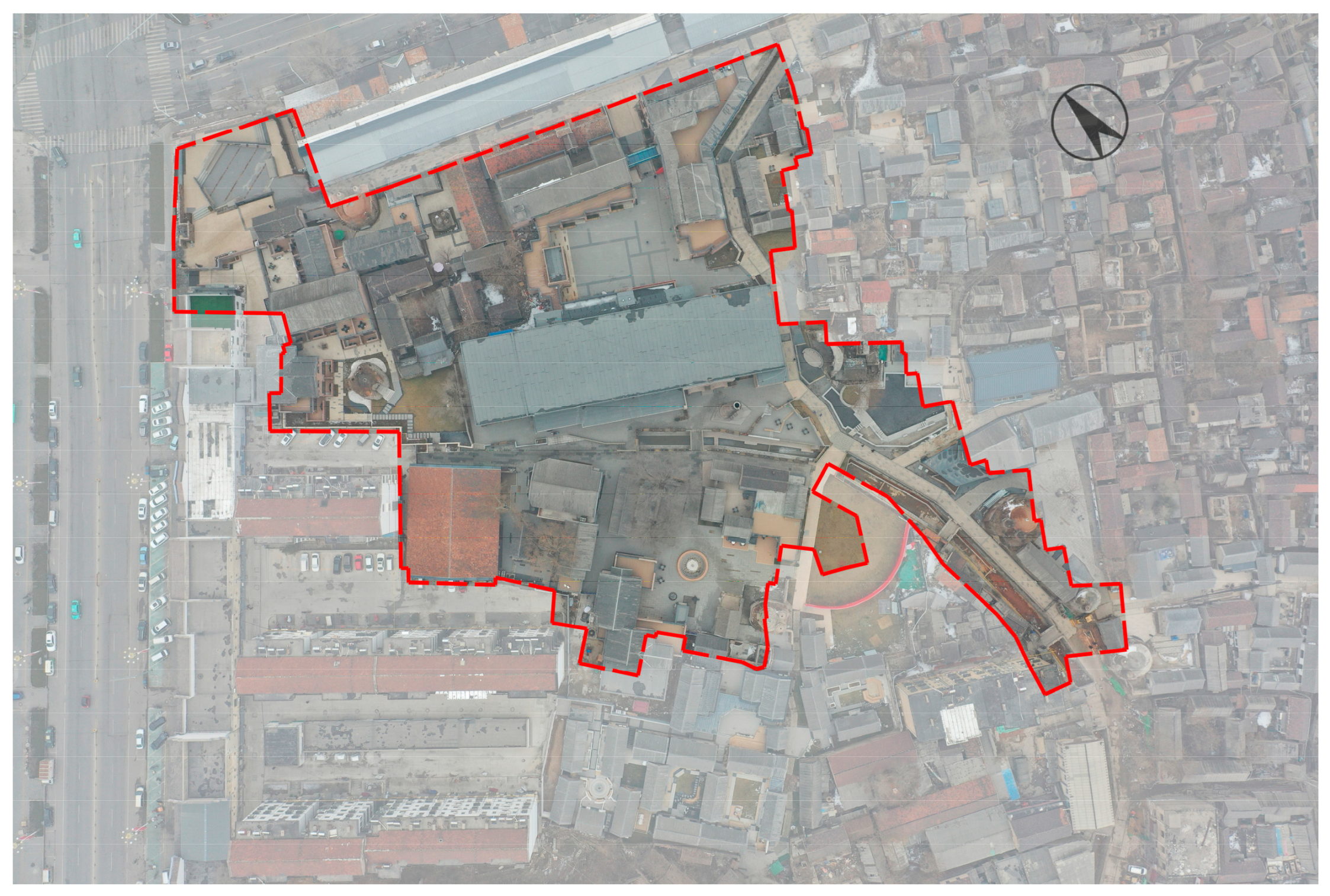






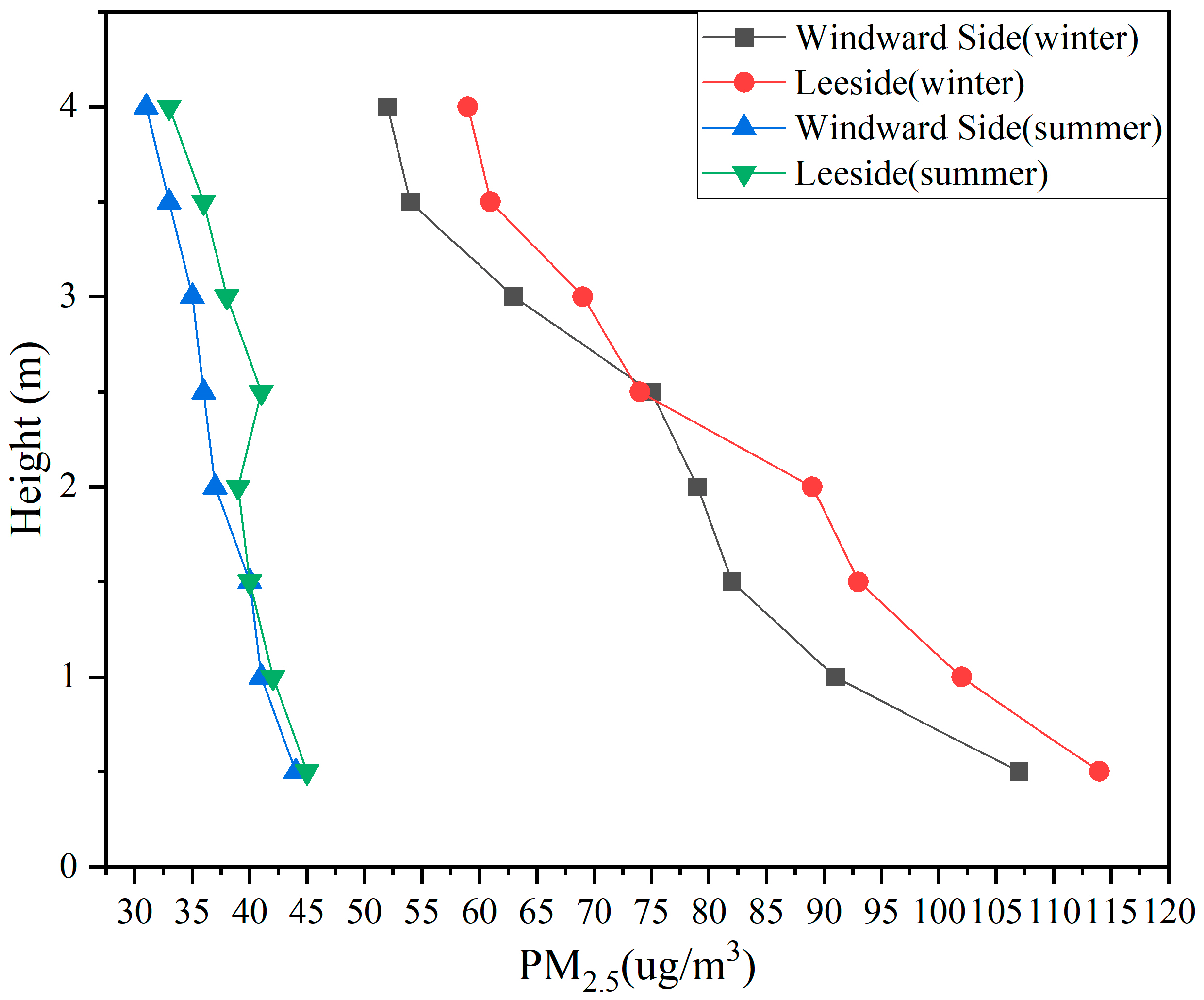

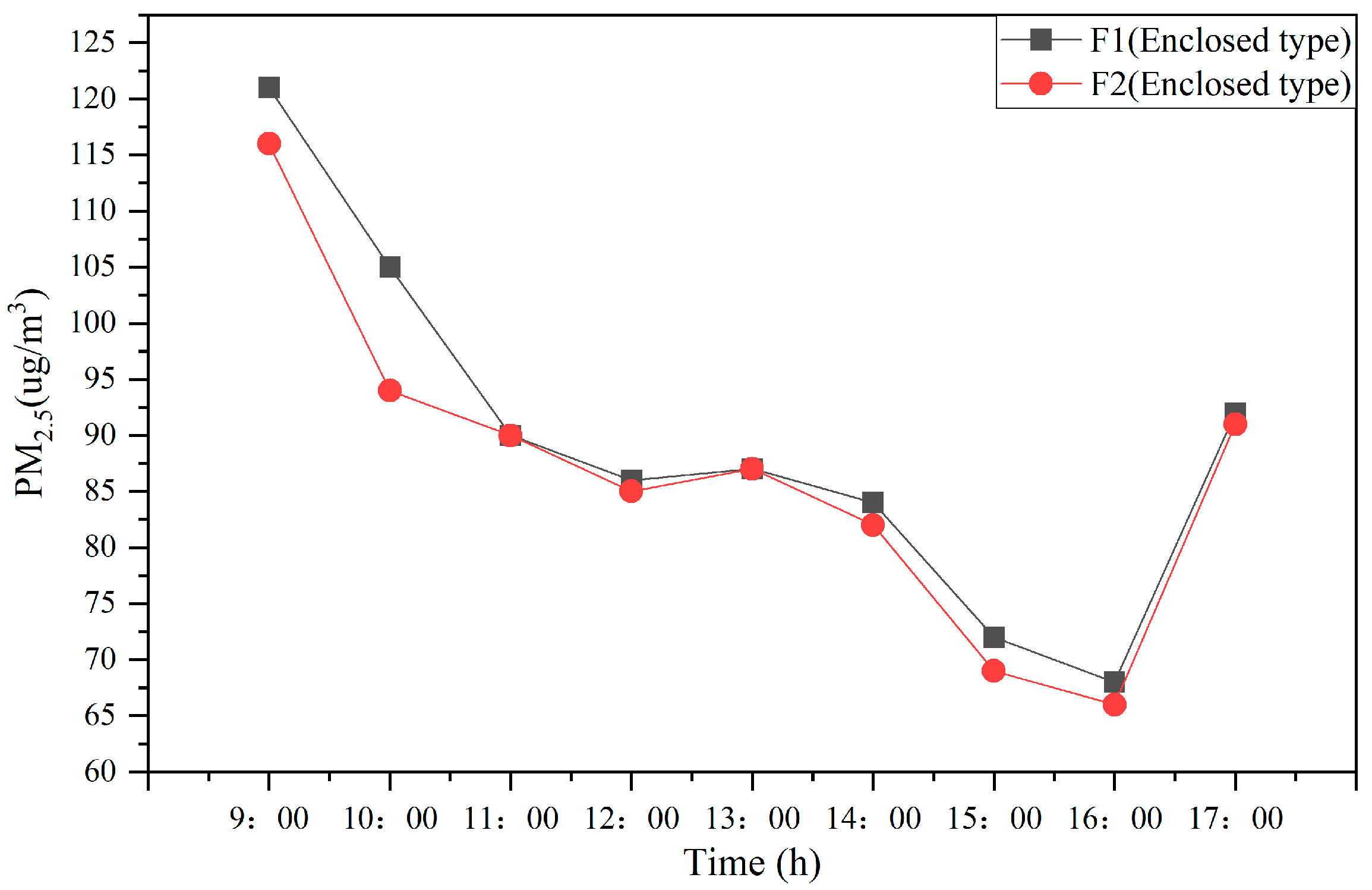
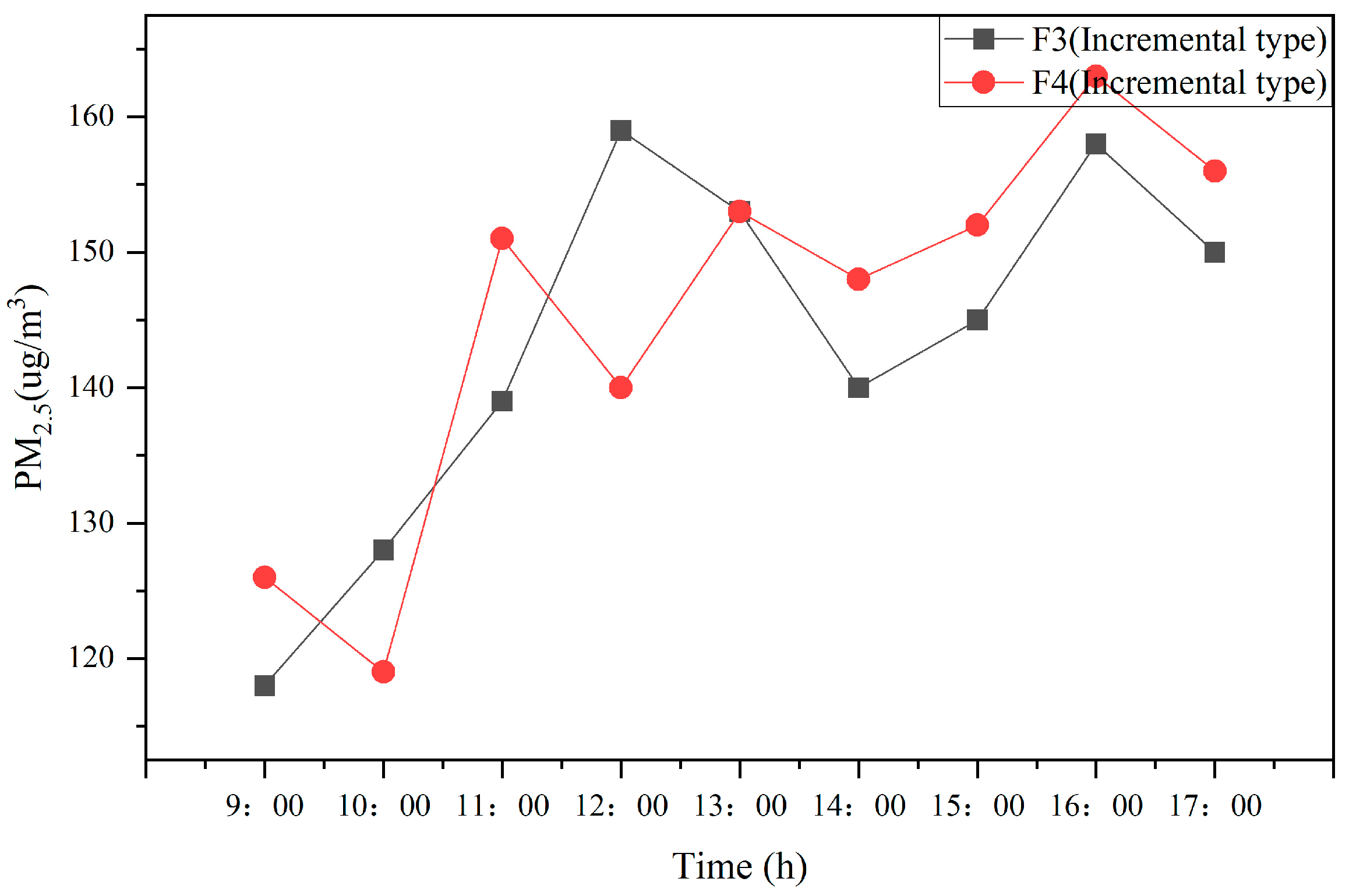
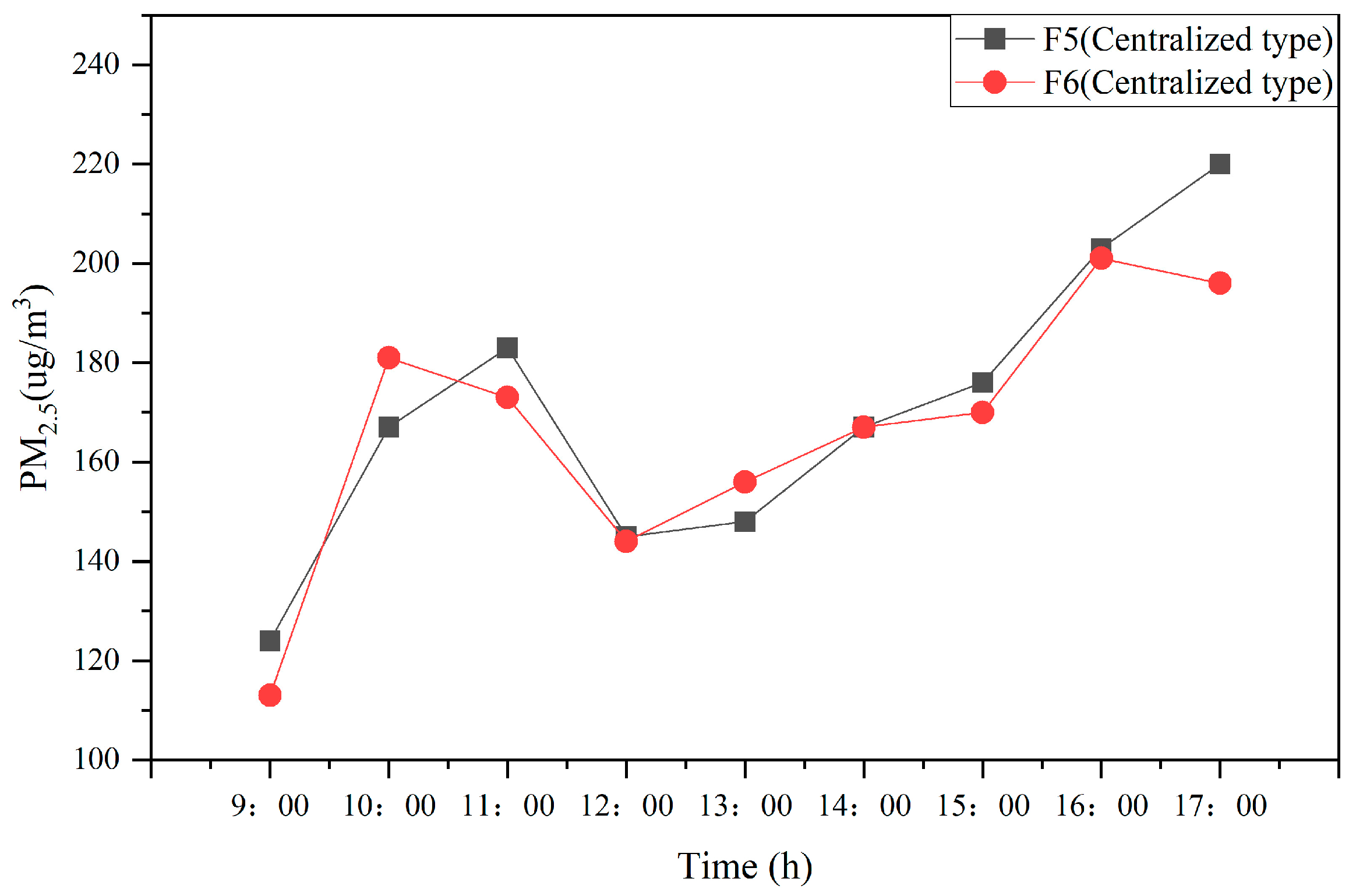
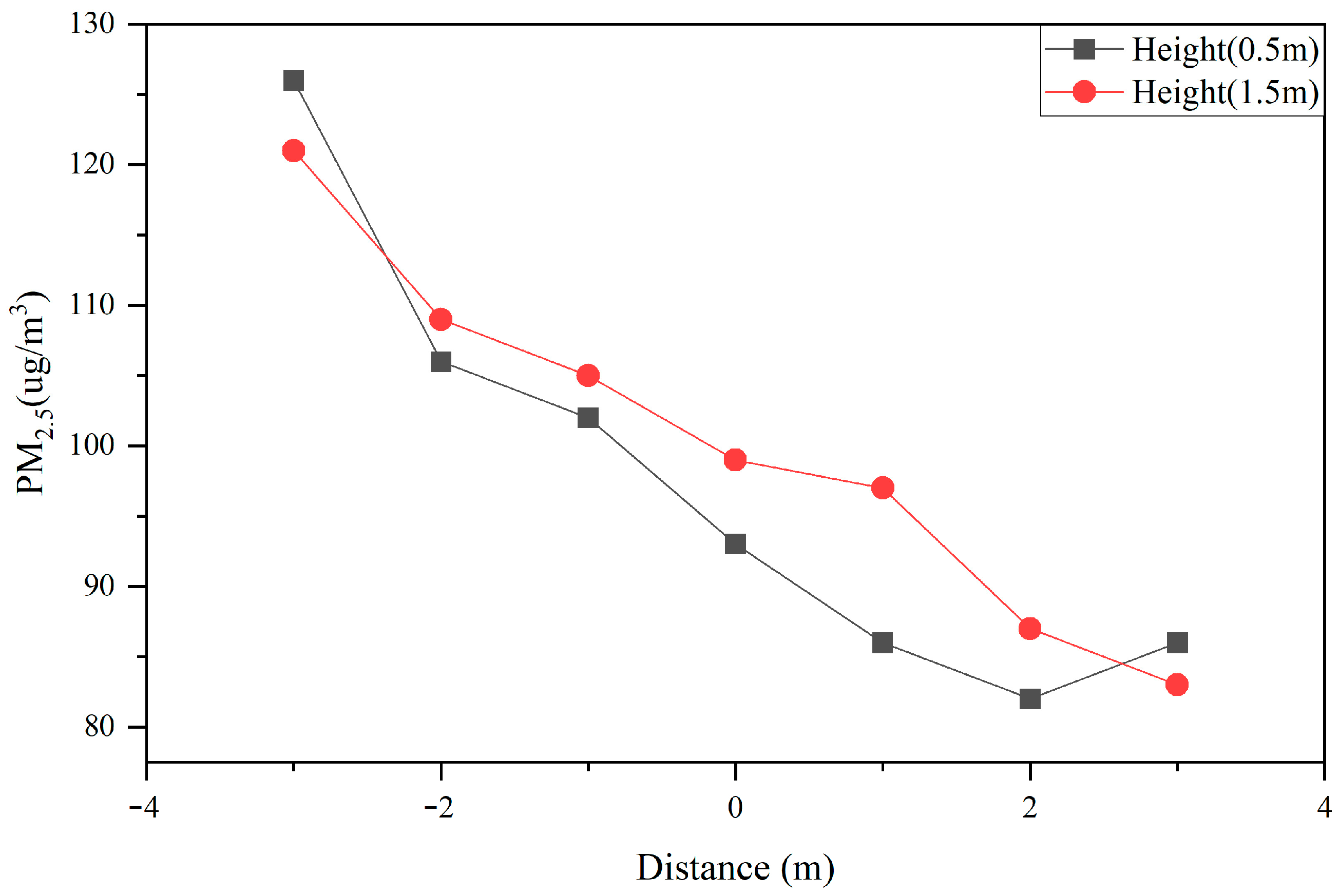
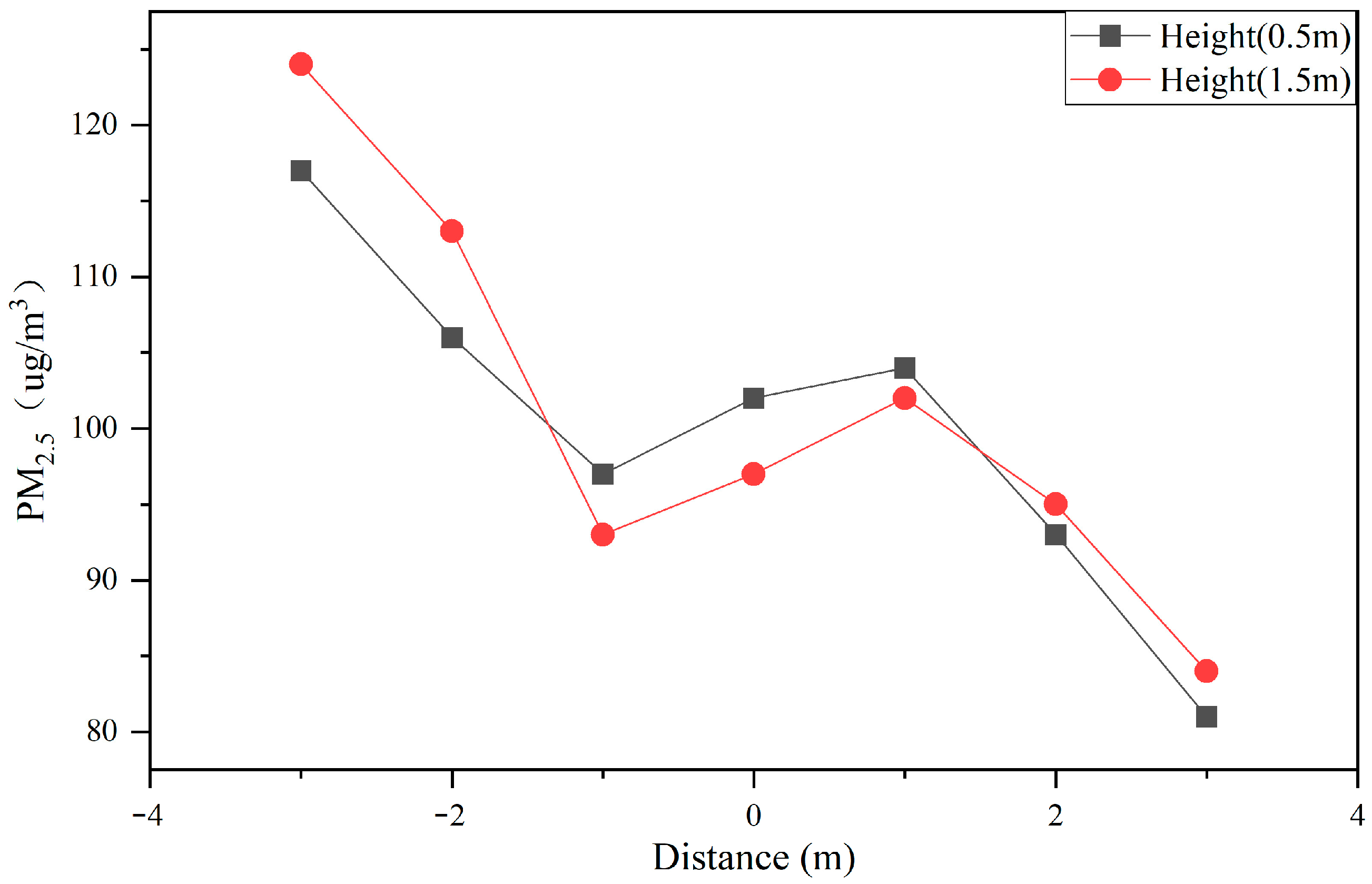
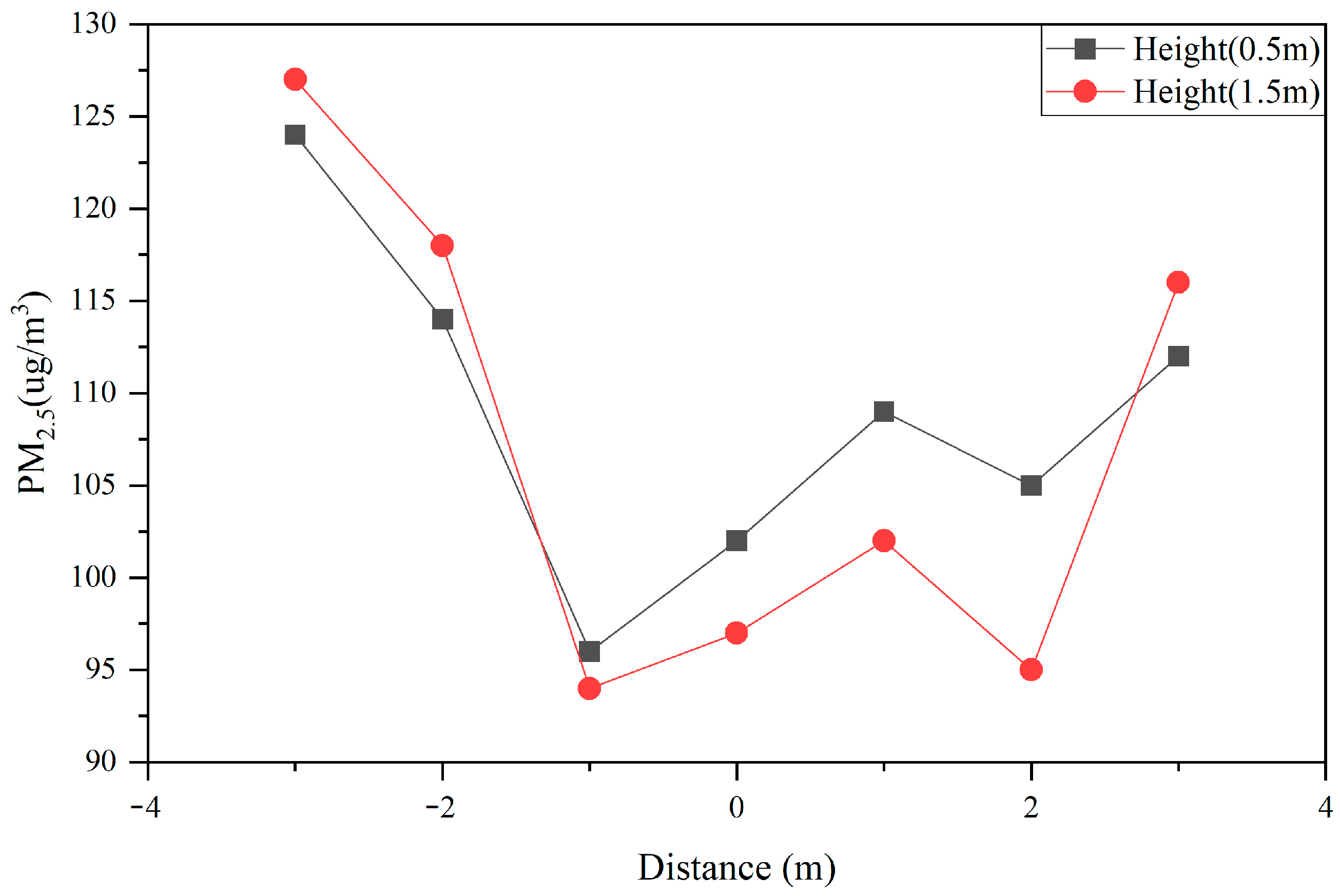
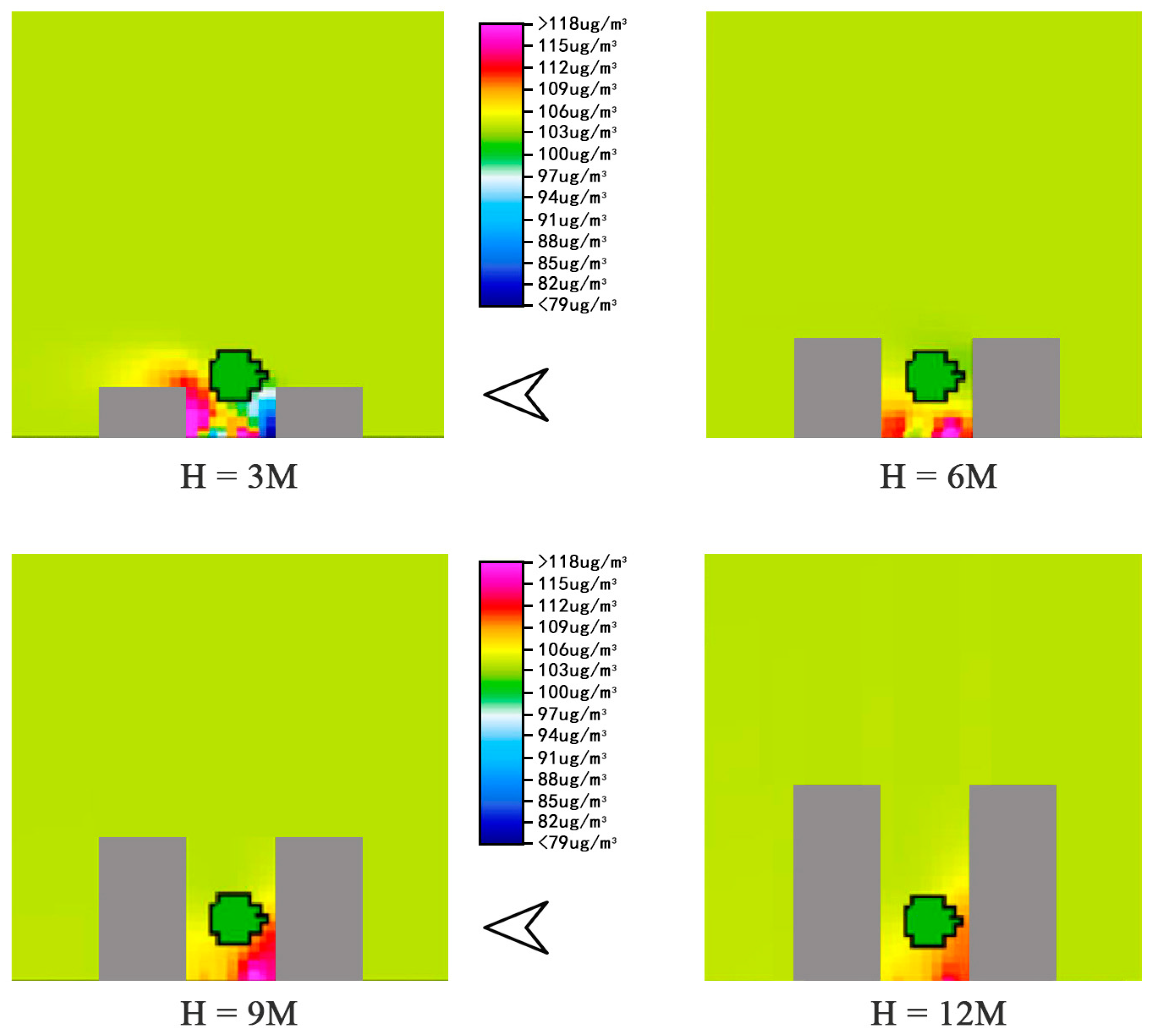
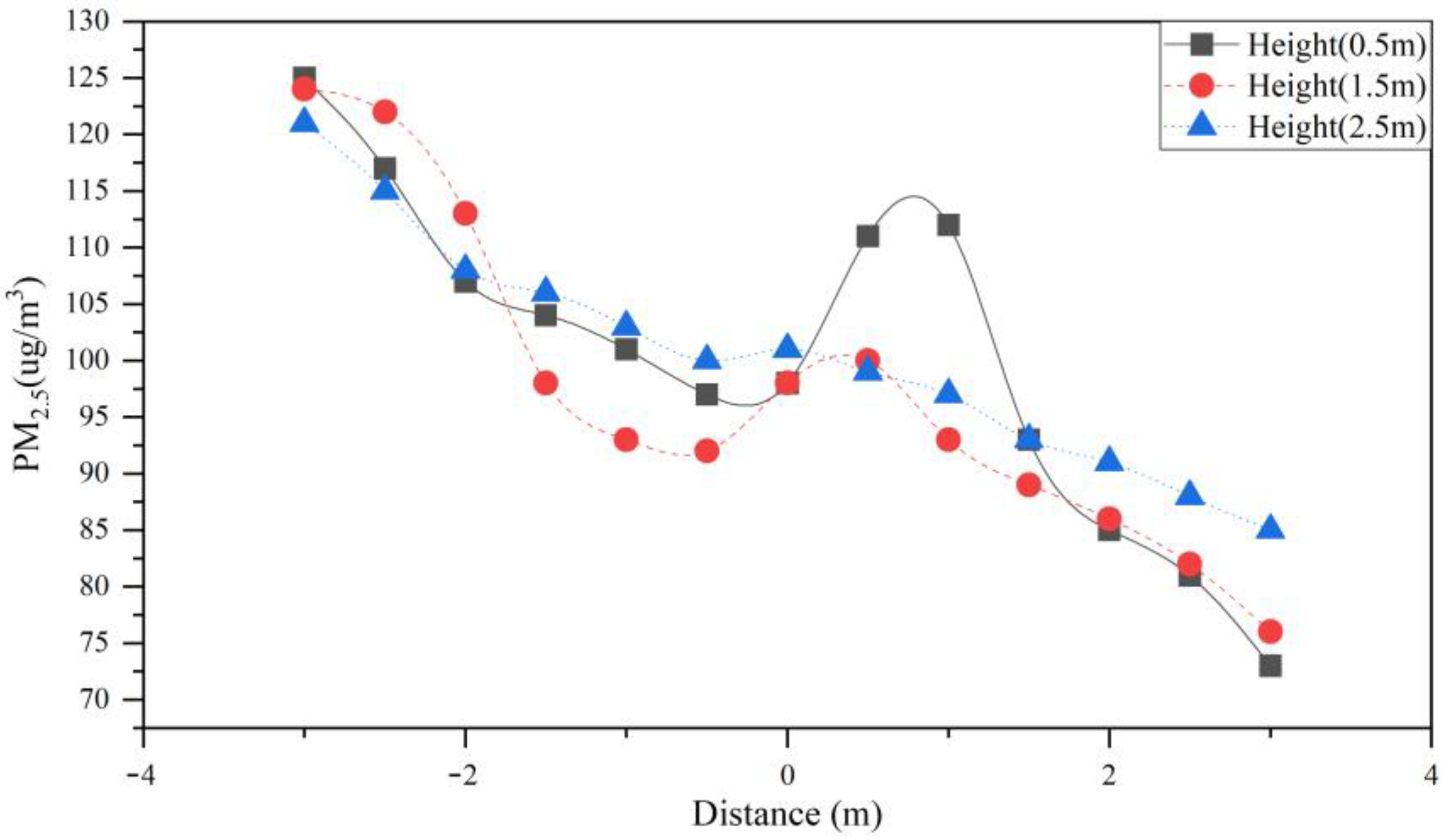
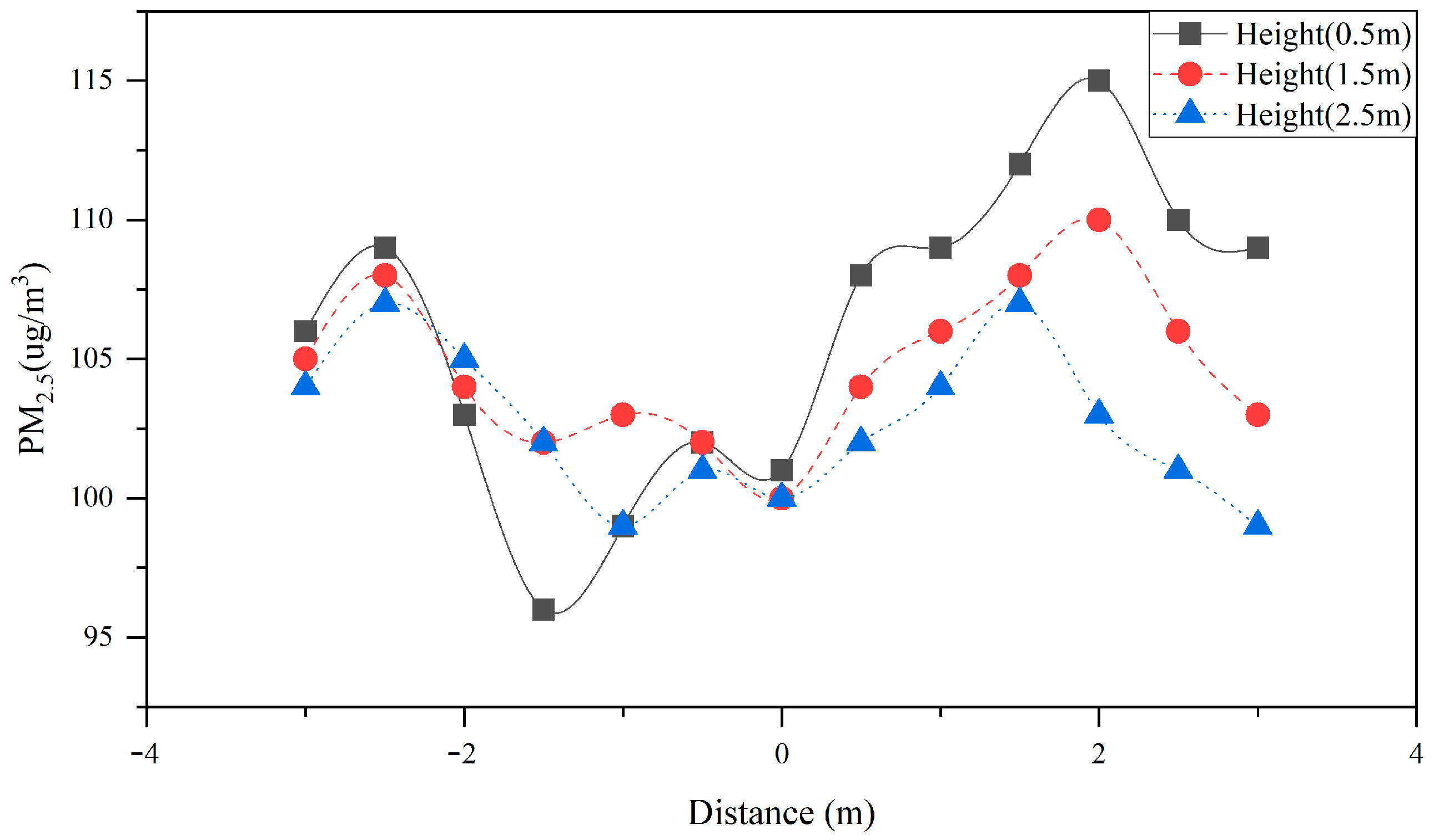
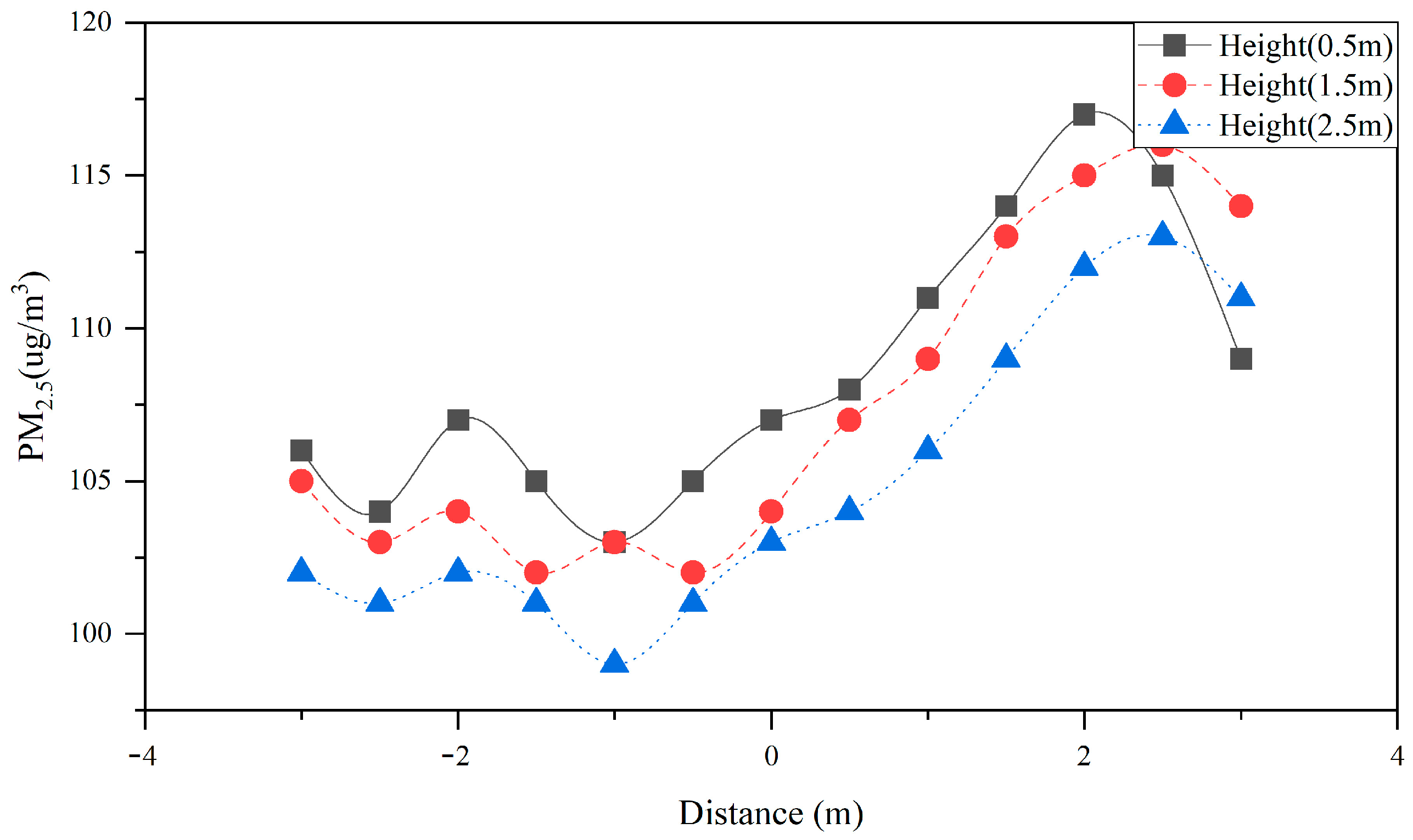
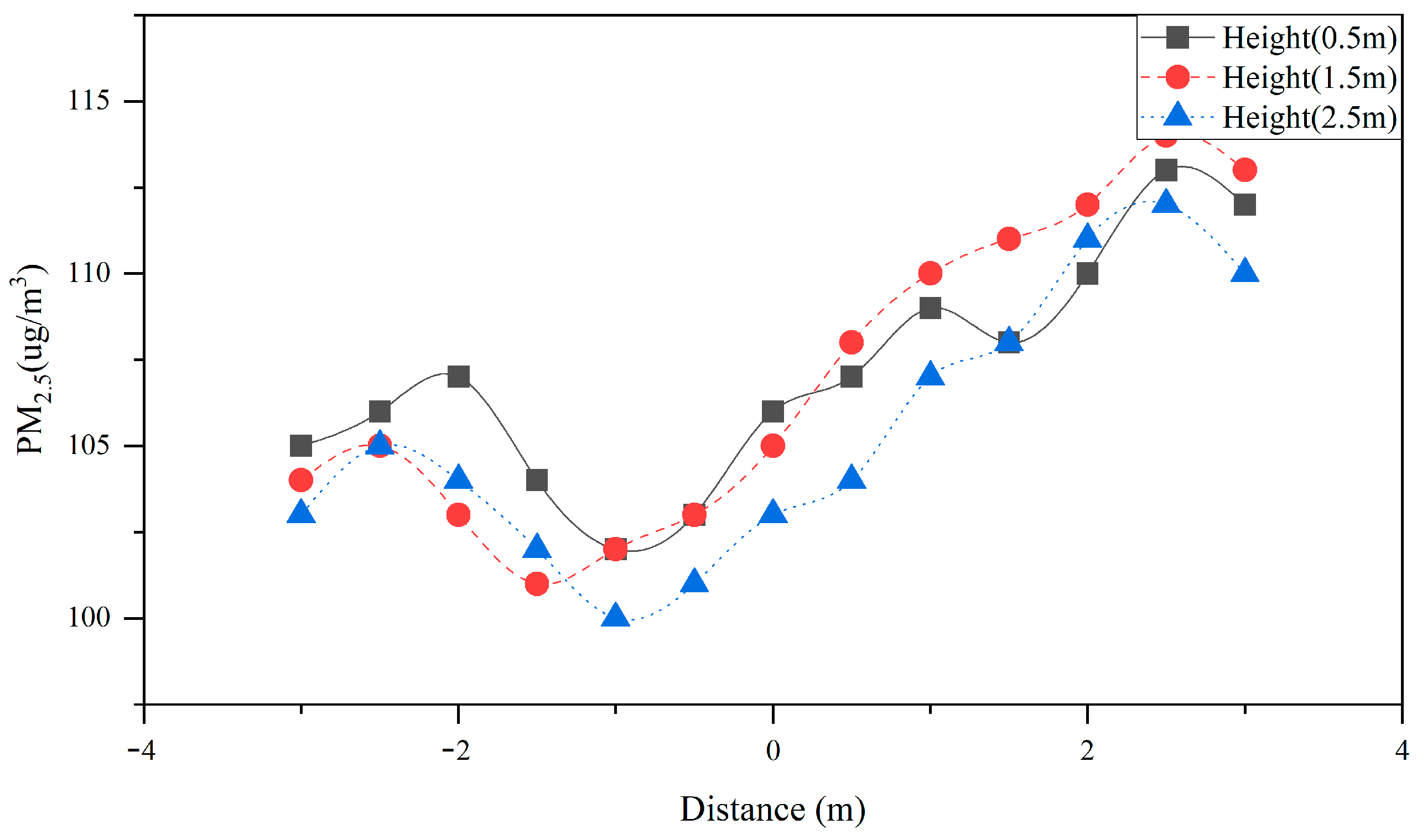
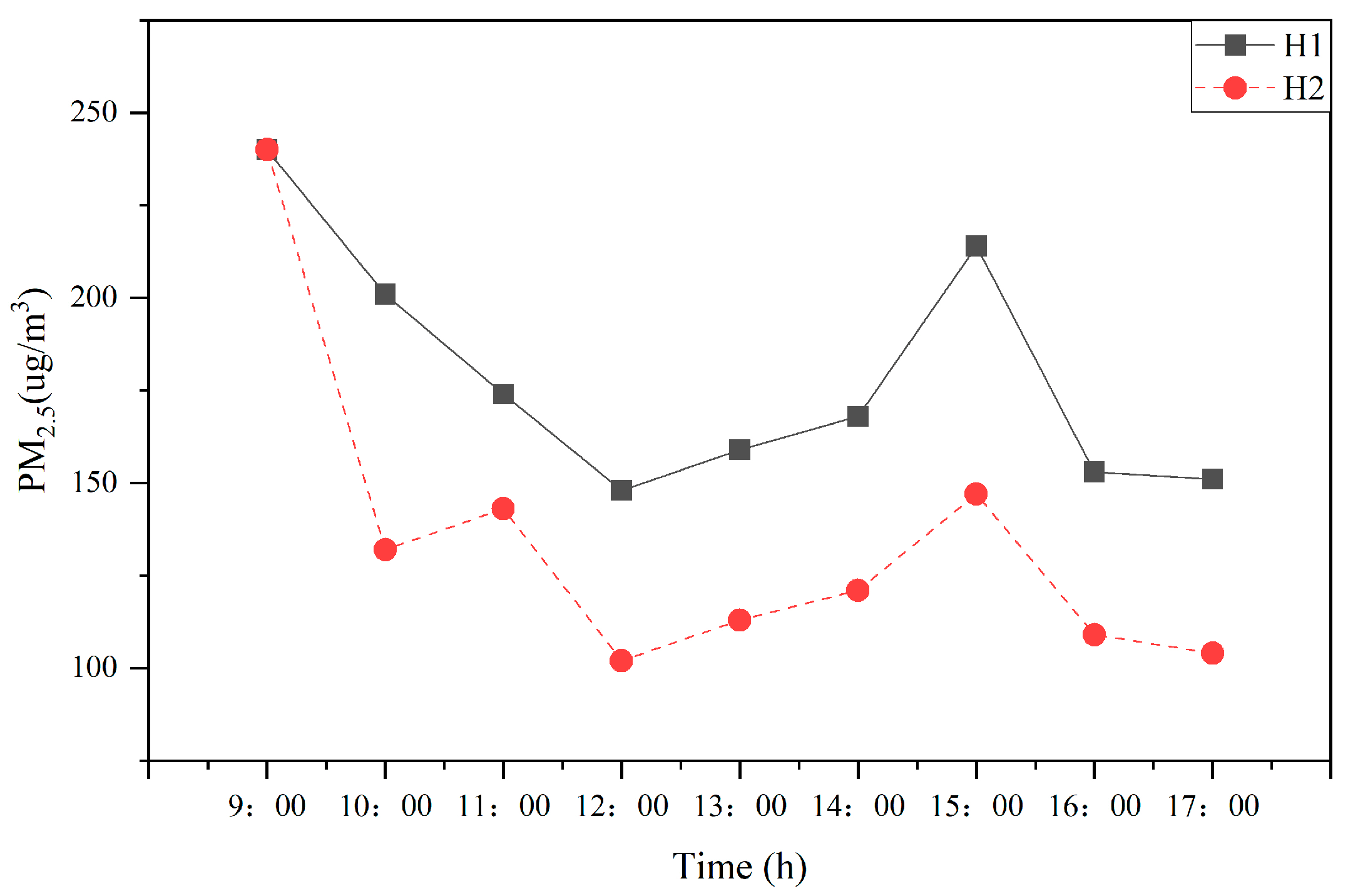
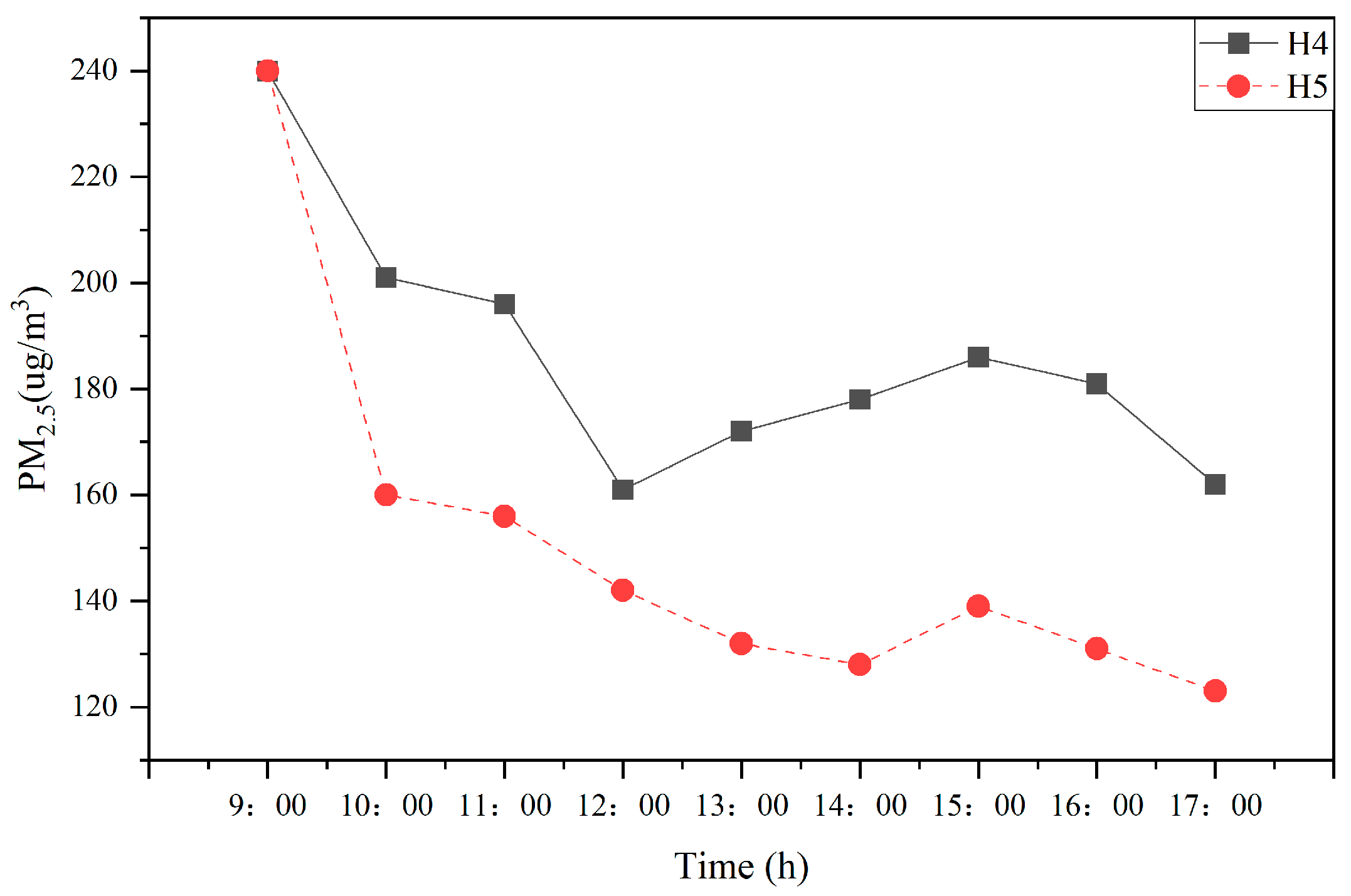
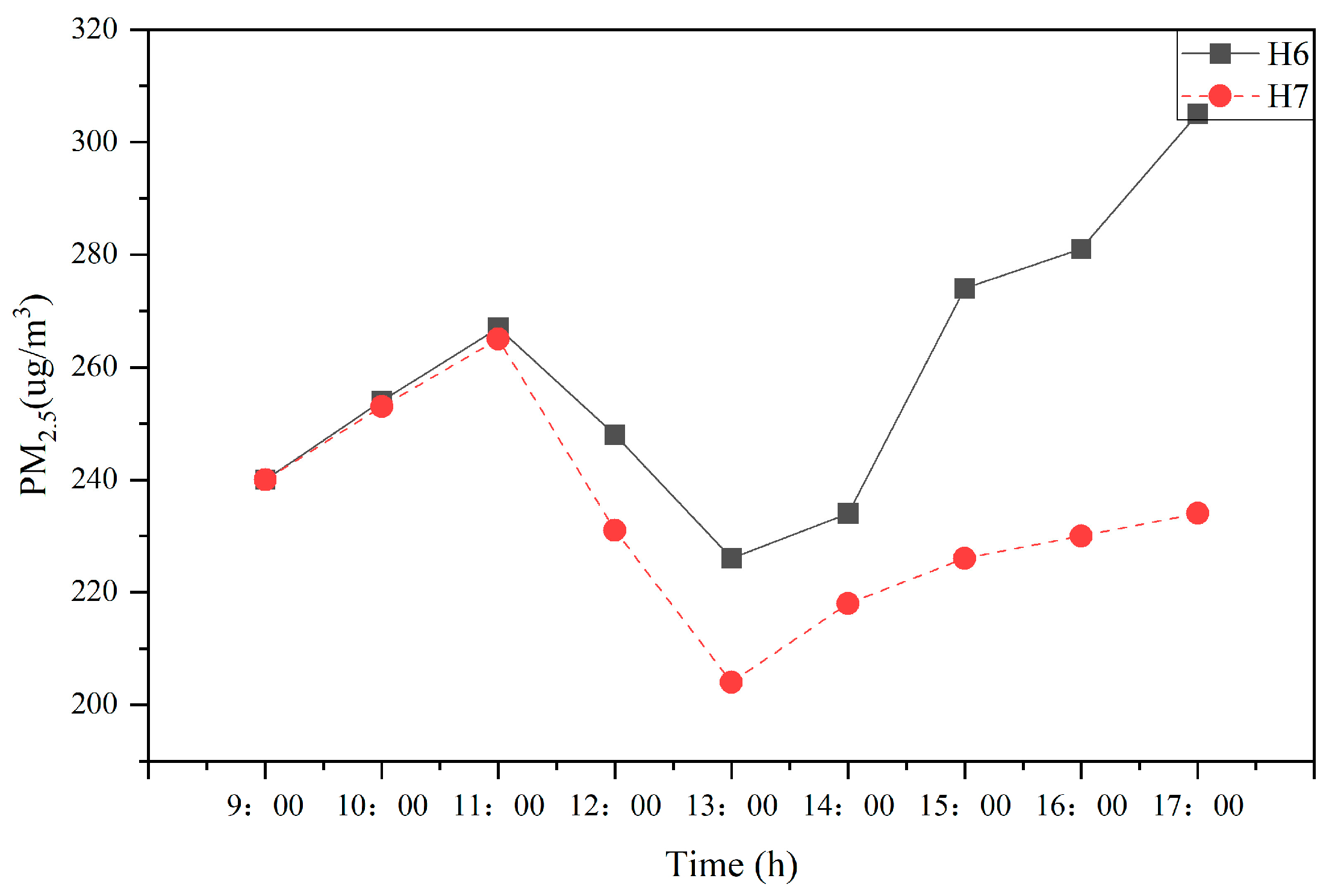

 | 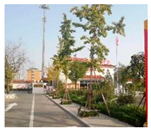 | 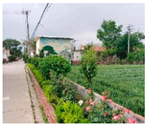 |  |
| D1 | D2 | D3 | D4 |
| Enclosed | Incremental | Centralized | |||
|---|---|---|---|---|---|
 |  |  |  |  |  |
| F1 | F2 | F3 | F4 | F5 | F6 |
 |  |  |  |
| H1 | H2 | H3 | H4 |
 |  |  |  |
| H5 | H6 | H7 | H8 |
| Wind Direction | Modeling Accuracy | Grid Type | Amplification Coefficient of Boundary Layer | Number of Grids |
|---|---|---|---|---|
| NE | 2/4 | Non-structural tetrahedral grid | 1.2 | 1,317,682 |
| SSW | 2/4 | Non-structural tetrahedral grid | 1.2 | 14,827,530 |
| Name | Air Quality Index | Air Quality Grade | Air Quality Level |
|---|---|---|---|
| P1 | AQI ≤ 50 | Grade 1 | Good |
| P2 | 50 < AQI ≤ 100 | Grade 2 | Moderate |
| P3 | 100 < AQI ≤ 15 | Grade 3 | Light polluted |
| P4 | 150 <AQI ≤ 200 | Grade 4 | Medium polluted |
| P5 | 200 < AQI ≤ 300 | Grade 5 | Heavy polluted |
| P6 | AQI > 300 | Grade 6 | Severe polluted |
| Item | Category | Mean Value | Standard Deviation | t | df | sig |
|---|---|---|---|---|---|---|
| Wind speed | Measurement | 0.89 | 0.23 | 2.21 | 6 | 0.078 |
| Simulation | 0.85 | 0.22 | ||||
| PM2.5 | Measurement | 97.11 | 4.12 | 2.26 | 6 | 0.065 |
| Simulation | 87.92 | 8.68 |
| Scientific Name | Species | Family Name | Application Range | Size, Shape | Material Object | Model |
|---|---|---|---|---|---|---|
| Quercus L. | Deciduous broadleaf trees | Fagaceae | Gap | 6 m high, with a canopy width of about 3 m, conical |  |  |
| Populus davidiana Dode | Deciduous trees | Willow family | Two sides of buildings, forest margins, open forests | 5 m high, with a canopy width of about 2–2.6 m, oval |  | |
| Betula platyphylla Sukaczev | Deciduous trees | Betulaceae | Gaps, two sides of buildings | 5 m high, with a canopy width of about 2–2.6 m, oval |  | |
| Lespedeza bicolor Turcz. | Erect shrubs | Rosaceae Leguminosae | Forest margins, gaps, outside of viaducts | 2–3.5 m high, with a canopy width of about 1.5–2.5 m, long oval |  |  |
| Ilex Chinensis Sims | Casuarina | Holly family | Northside of the building, open forest | 2–2.5 m high, with a canopy width of about 1.2–1.8 cm, spherical |  | |
| Acer palmatum Thunb. | Small deciduous trees | Maple family | Forest margins | 1.5–2.5 m high, with a canopy width of about1.5–2 m, oval |  | |
| Amygdalus triloba (Lindl.) Ricke | Shrubs and small trees | Rosaceae | Both sides of the building, forest margins | 1–2.5 m high, with a canopy width of about 1–1.5 m, oval | 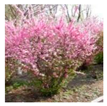 | |
| Arundinella anomala Steud. | Herbs | Gramineae | Forest margins, both sides of buildings | 0.6–1.1 m high, with a canopy width of about 0.5 m, oval |  |  |
| Themedajaponica (Willd.) Tanaka | Herbs | Gramineae | Open forests, forest margins | 0.7–1.5 m high, with a canopy width of about 0.7–0.8 m, long circular |  |
Publisher’s Note: MDPI stays neutral with regard to jurisdictional claims in published maps and institutional affiliations. |
© 2022 by the authors. Licensee MDPI, Basel, Switzerland. This article is an open access article distributed under the terms and conditions of the Creative Commons Attribution (CC BY) license (https://creativecommons.org/licenses/by/4.0/).
Share and Cite
Wang, F.; Sun, B.; Zheng, X.; Ji, X. Impact of Block Spatial Optimization and Vegetation Configuration on the Reduction of PM2.5 Concentrations: A Roadmap towards Green Transformation and Sustainable Development. Sustainability 2022, 14, 11622. https://doi.org/10.3390/su141811622
Wang F, Sun B, Zheng X, Ji X. Impact of Block Spatial Optimization and Vegetation Configuration on the Reduction of PM2.5 Concentrations: A Roadmap towards Green Transformation and Sustainable Development. Sustainability. 2022; 14(18):11622. https://doi.org/10.3390/su141811622
Chicago/Turabian StyleWang, Feng, Bo Sun, Xin Zheng, and Xiang Ji. 2022. "Impact of Block Spatial Optimization and Vegetation Configuration on the Reduction of PM2.5 Concentrations: A Roadmap towards Green Transformation and Sustainable Development" Sustainability 14, no. 18: 11622. https://doi.org/10.3390/su141811622





